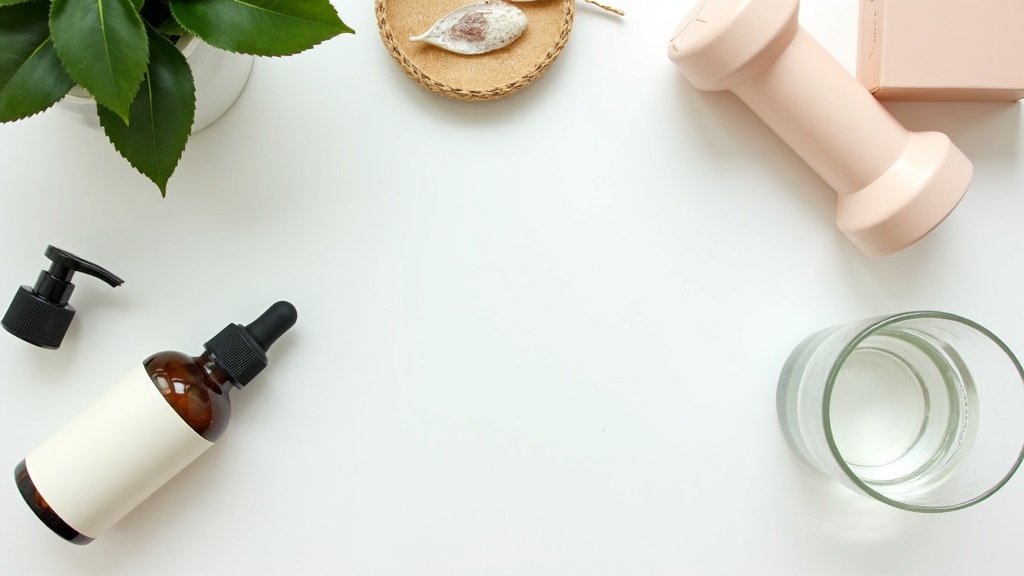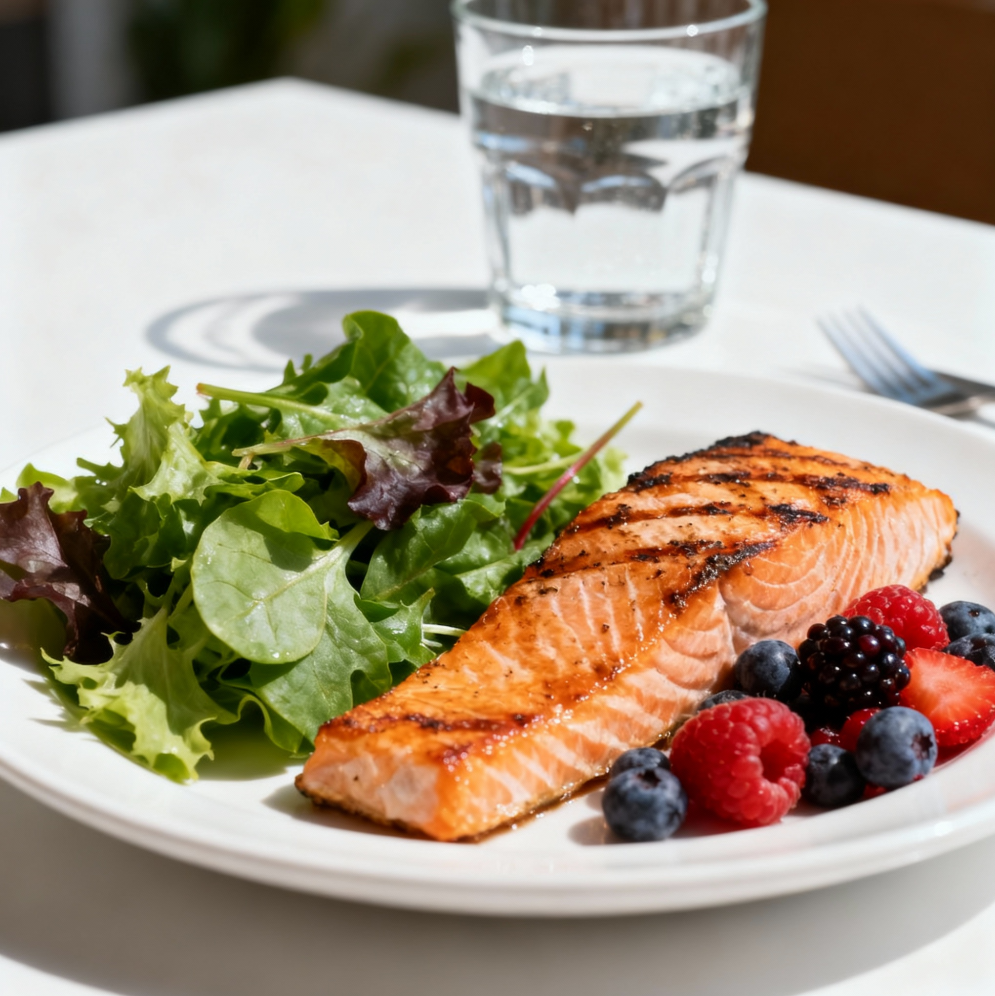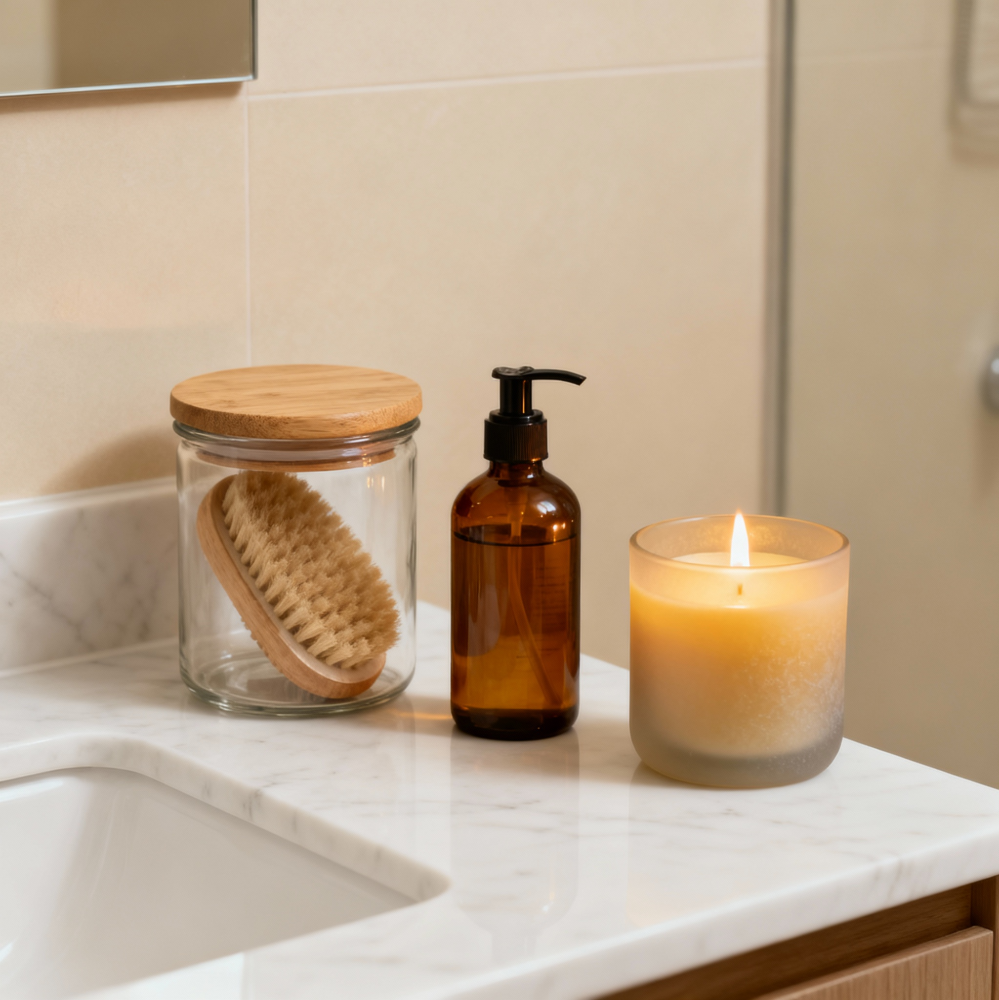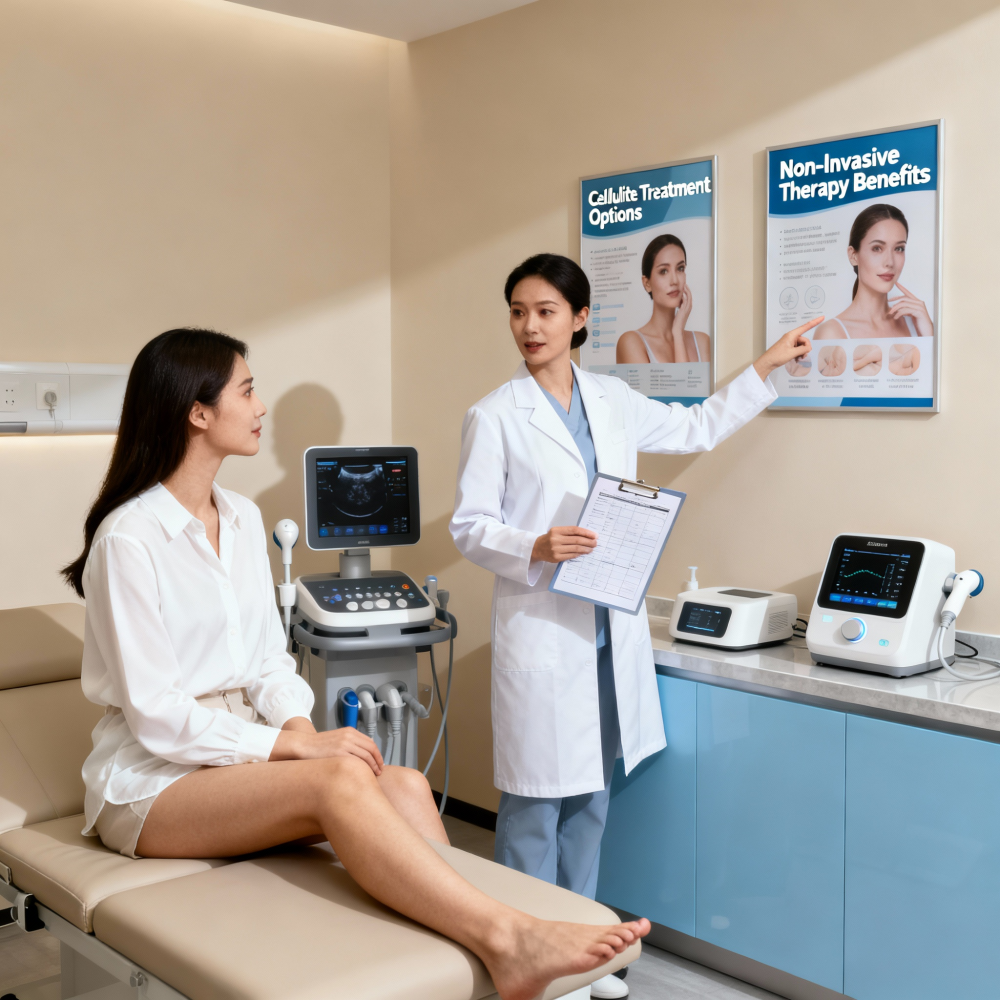Welcoming your new baby brings a world of change. Both joyful and challenging moments fill your days. One change often talked about quietly (or not at all) is how our bodies look and feel after pregnancy.
If you’re noticing more cellulite after having your baby, you’re not alone. Up to 90% of women experience cellulite at some point in their lives, according to the American Academy of Dermatology. It’s especially common for cellulite to appear or worsen after pregnancy due to hormonal shifts and changes in skin and body composition.
Clinical research published in the Journal of Cosmetic and Laser Therapy has shown that non-invasive treatments can improve the appearance of postpartum cellulite in new moms (see study abstract on PubMed).
Hormonal shifts, the way skin stretches, and those shifting numbers on the scale all play a part. It’s easy to feel frustrated, especially when filters and celebrity snapshots make it seem like everyone else is bouncing back overnight.
But the good news is there are straightforward, realistic ways to help your body recover, boost your confidence, and feel more at home in your skin again. I’ve looked at what actually works (and what isn’t worth your time), focusing on strategies you can fit into real mom life. No crash diets or miracle cures, just honest, practical steps forward.

What’s Really Going On With Post Pregnancy Cellulite?
Cellulite isn’t a sign you’ve “let yourself go.” It’s completely normal, especially after pregnancy. Think of cellulite as fat deposits that push against the connective tissue under your skin, causing those dimpled or lumpy areas.
According to the Mayo Clinic, some women barely notice it, while for others, it’s more pronounced. Genetics have a huge say in whether we get cellulite and how much of it we have. If your mom or sister has it, there’s a strong chance you might notice it too, especially after pregnancy.
Pregnancy brings a mix of hormonal changes, like surges in estrogen and the appearance of relaxin. These hormones can soften the connective tissue and make the fat beneath your skin more noticeable.
Add in typical pregnancy weight gain and extra fluid retention (hello, swollen feet!), and your skin stretches to accommodate your growing baby. The American College of Obstetricians and Gynecologists notes that these physiological changes are completely normal and expected during pregnancy.
After birth, you might see improvements as your body rebounds. Usually, it can take 6-12 months or more for things to settle down as your hormones shift back and your skin, muscles, and fat deposits adjust.
Some people notice changes sooner, and for others, it’s a slower, more gradual improvement. So, patience is key. Your body has already done something incredible!
Nutrition for Smoother Skin and More Energy

Food won’t erase cellulite, but what you eat can help support your skin and how your body stores fat and fluids. Making small, sustainable changes works way better than swinging between strict diets and food guilt, especially when you’re up at 3 a.m. rocking a fussy baby.
Hydration comes first: Aim for 8-10 cups of water a day. If you’re breastfeeding, the Academy of Nutrition and Dietetics recommends you may need even more, up to 13 cups daily.
Keeping a water bottle handy during feeds or stroller walks makes it easier to remember to drink. I started using a 32-ounce bottle and made it my goal to finish two per day, which felt more manageable than counting glasses.
Load up on anti-inflammatory foods: Berries, leafy greens (kale, spinach, arugula), tomatoes, beans, avocados, and fatty fish such as salmon all help keep your skin tissues healthier by fighting cell damage and inflammation. Research in Dermatology and Therapy suggests that antioxidant-rich foods support skin health from the inside out.
Collagen-supporting nutrients: Vitamin C (citrus fruits, bell peppers, strawberries, broccoli) and amino acids (found in eggs, chicken, tofu, Greek yogurt, or legumes) are important for your skin’s elasticity and strength.
Including 20-30 grams of protein in each meal helps deliver these building blocks throughout your day. I found that adding a hard-boiled egg to breakfast and a handful of almonds to my afternoon snack made a noticeable difference in my energy levels.
Watch sodium and processed foods: Lots of salt, packaged snacks, and sugary treats can make fluid retention worse and leave your skin looking puffier. The American Heart Association recommends limiting sodium to 2,300mg daily, and ideally 1,500mg.
If possible, swap out chips for roasted nuts or fresh fruit for dessert. Keep it simple and don’t stress about perfection.
Breastfeeding considerations: Keep nutrition balanced and avoid drastic diets while nursing. A steady supply of calories (typically 450-500 extra calories per day according to La Leche League), vitamins, and minerals helps both your recovery and your baby.
Easy Meal Prep Ideas for Busy Moms
Meal prep isn’t easy between diaper changes and nap traps, but here are some realistic strategies:
- Big batch soups: Make a large pot of lentil, chicken vegetable, or minestrone soup on Sunday. Portion into individual containers for grab-and-go lunches all week.
- Overnight oats: Mix rolled oats, chia seeds, berries, and almond milk in mason jars before bed. Breakfast is ready when you wake up.
- Snack trays: Prep celery with almond butter, hummus with carrots, apple slices with string cheese, or trail mix portions in small containers.
- Sheet pan dinners: Roast salmon or chicken with sweet potatoes, broccoli, and bell peppers on one pan. Minimal cleanup, maximum nutrition.
If you’re able to include wholesome grains like quinoa and brown rice along with healthy fats (walnuts, olive oil, chia seeds, and avocado), you’re doing your skin a big favor. These all play a subtle but steady part in keeping your connective tissues resilient.
Exercise and Movement: Building Back Strength and Confidence
Getting moving again can feel intimidating when you’re running on limited sleep, but it pays off for cellulite, your energy, and your mood. Strength training is especially effective because building muscle can make skin look firmer as your body composition changes.
Before starting: It’s super important to check in with your healthcare provider. The American College of Obstetricians and Gynecologists notes that many women get the green light for light exercise around 6 weeks postpartum for vaginal deliveries and 8-12 weeks for cesarean sections.
Some need longer based on their delivery and recovery. Listen to your body and ease in slowly.
Strength Training Specifics
These exercises build muscle in your legs, glutes, and core, which are common spots for cellulite:
Bodyweight squats:
- Start with 2 sets of 10-12 reps
- Progress to 3 sets of 15 reps
- Focus on sitting back like you’re reaching for a chair, keeping knees behind toes
Watch a demo of proper squats:
Lunges:
- Begin with 2 sets of 8 reps per leg
- Work up to 3 sets of 12 reps per leg
- Try forward lunges, then progress to reverse lunges for variety
Watch a demo of proper lunges:
Glute bridges:
- 3 sets of 15-20 reps
- Squeeze glutes at the top for 2 seconds
- Add a resistance band around thighs for extra challenge
Watch a demo of proper glute bridges:
Deadlifts (with light weights or resistance bands):
- Start with 2 sets of 10 reps
- Progress to 3 sets of 12-15 reps
- Keep back straight, hinge at hips
Frequency: 2-3 times a week is more than enough. Focus on short, doable workouts, think 15-25 minutes. Consistency matters more than intensity.
Watch a demo of proper deadlifts:
Cardiovascular Exercise
Walking: With or without a stroller, this is one of the most accessible options. Try to fit in 20-30 minutes most days, building up to 150 minutes weekly.
I often walked with a new mom friend and found it really helpful for accountability and stress relief. We’d aim for three 30-minute walks per week.
Swimming: Excellent low-impact option that works your whole body while supporting joints. Even 20 minutes twice weekly makes a difference.
Cycling: Whether on a stationary bike during nap time or outdoors, cycling boosts circulation and builds leg strength.
Gentle Options for Early Days
Postnatal yoga or Pilates can help you reconnect with your core, support healing (especially for diastasis recti), and improve posture. All of which matter for cellulite and overall wellbeing. Look for certified postnatal instructors who understand the specific needs of postpartum bodies.
Baby-friendly tips:
- Hold your little one during squats (they become your progressive weight!)
- Try tummy time while you plank nearby
- Do wall push-ups during play time
- Practice calf raises while rocking baby to sleep
Progress is different for everyone. Some moms notice smoother-looking legs and tighter skin after 3-4 months of regular effort. Setting realistic goals and focusing on how your body feels, rather than just looks, can keep you feeling positive throughout your journey.
You’ll find more guidance on targeted movement routines (like those covered in the Joey Atlas Symulast Exercises Review) on our site.
Even low-impact activities have ripple effects. Stretching before bed, taking the stairs instead of an elevator, or doing seated calf raises while feeding the baby all add up to a stronger body and more empowered postpartum experience.
Topical Treatments and Self-Care at Home

Creams, brushes, and massages are all over the internet as quick fixes for postpartum skin. For most, the results are modest and temporary, but these self-care tools can still play a part in your cellulite recovery, especially for relaxation and connection with your body.
Dry brushing: Using a soft-bristled natural brush before your shower (always brush toward your heart in gentle, circular strokes) helps boost circulation and may temporarily make skin look smoother. Start at your feet and work upward.
Do this 3-4 times a week for best results. The technique takes just 5 minutes and feels invigorating.
Massage: Gentle self-massage or using a foam roller for 5-10 minutes nightly can encourage lymphatic drainage. Over time, I noticed my legs felt less puffy and even my jeans slipped on a bit easier.
Focus on areas where you notice cellulite, using firm but comfortable pressure.
Caffeine-based creams: Research in the Journal of Cosmetic Dermatology shows these can temporarily tighten the skin through dehydration of fat cells. They’re helpful for a confidence boost before a special event. Just don’t expect lasting changes from creams alone.
Apply after showering when skin is slightly damp for better absorption.
Retinol products: Retinol can slightly thicken skin and help with texture over time, but always check with your doctor if you’re breastfeeding. The American Academy of Dermatology recommends introducing new skincare slowly to monitor for sensitivity.
My tip: Make self-massage or dry brushing a mini ritual. Even 5 minutes can be a mood lifter and build a sense of self-care into your week. That emotional boost can be just as valuable as the (subtle) physical changes.
I turned mine into a pre-shower routine paired with a favorite podcast, which made it something I actually looked forward to rather than another chore.
For added TLC, consider blending natural oils like coconut or sweet almond with a drop of lavender essential oil for massage. The soothing scent can help you relax and potentially improve sleep quality, making your self-care time even more restorative.
Lifestyle Tweaks That Make a Difference
Healthy habits play a huge part in how your skin and body adjust during postpartum recovery. Most aren’t rocket science, but putting together a few supportive routines can help smooth things over, literally and figuratively.
Get as much sleep as possible: Sleep disruption is real for new moms, but even short 20-30 minute naps or swapping nighttime feedings with your partner can help your body recover and keep stress hormones in check.
The National Sleep Foundation emphasizes that sleep is when your body does crucial repair work, including skin regeneration.
Manage stress: High cortisol (your stress hormone) can contribute to more stubborn body fat and fluid retention. Studies published in Psychneuroendocrinology link chronic stress to increased abdominal fat storage.
Meditation apps, deep breathing exercises (try the 4-7-8 technique), or even two quiet minutes in the bathroom away from the chaos can make a difference. I used the Calm app for quick 5-minute guided meditations to reset during tough days. It felt more manageable than trying to fit in a full 20-minute session.
Skip smoking and limit alcohol: Smoking damages your skin’s collagen and circulation. Drinking too much can increase puffiness and slow recovery.
If you drink, keep it light (no more than 1 drink per day) and don’t stress about the occasional glass.
Compression wear: Wearing compression leggings during your workouts can help with comfort, circulation, and the feeling of support, especially if you’re still healing from diastasis recti or have loose skin. Look for medical-grade compression if you’re dealing with significant swelling.
Weight loss, slowly: If your provider says it’s okay and you want to lose weight, go for a gradual approach. The CDC recommends aiming for 1-2 pounds a week at most.
Rapid dieting often backfires, especially when you’re juggling motherhood and your own recovery. Remember: it took 9 months to grow your baby; give yourself at least that long to adjust.
Habit Stacking for Success
If you find routines tricky to maintain, try stacking new habits with daily activities:
- Stretch your calves while waiting for your coffee to brew
- Sip water at every feeding session
- Do squats while warming up baby’s bottle
- Practice deep breathing during diaper changes
- Take a 5-minute walk after each meal
These mini tweaks add up, helping you get a handle on your recovery without overwhelming yourself. Small, manageable changes beat big overhauls every time, especially when you’re already doing a million things for your family.
Mental Health and Feeling Good About Your Postpartum Body
Cellulite after baby isn’t just about what you see in the mirror. There’s a real emotional toll when your body feels new and unfamiliar, especially in a world that glorifies “getting your body back.”
But here’s the thing: your body just grew a human. Pretty amazing by any standard.
Check your expectations: Recovery is not linear. Remember, social media shows the highlight reel, not the whole process. Filters, lighting, clever posing, and sometimes even postpartum shapewear can create illusions that aren’t reality.
A study in Body Image journal found that social media use is associated with increased body dissatisfaction, particularly among new mothers.
Celebrate what your body can do: Strong biceps from all those stroller pushes? A baby who loves to be held? Those are victories worth noticing.
Focusing on movement, function, and feeling strong often creates a cycle of increased confidence and positivity. Instead of “my thighs have cellulite,” try reframing to “my legs carried me and my baby on a beautiful walk today.”
Find your tribe: Whether through local mom groups, online forums like the What to Expect community, or even a few supportive friends, community is huge. Swapping real information and encouragement with others can help shift the narrative from “flaws” to shared experiences.
I once connected with another new mom at the park. We both admitted to feeling weird about our new shapes, but sharing honest stories left us both feeling lighter. Sometimes, saying it out loud helps dissolve the shame and makes room for acceptance (or at least neutrality) about things outside of our control.
Talk to someone if you’re struggling: If worries over your appearance get overwhelming or you feel down for days at a time, talk to your provider, a counselor, or call the Postpartum Support International helpline at 1-800-944-4773.
According to Postpartum Support International, up to 1 in 7 women experience postpartum depression, and body image concerns can be part of that picture. It’s 100% normal to need support during big transitions.
Quick Start Checklist: Building Body Confidence After Baby
✓ Say one positive thing about your body (aloud or in a journal) daily
✓ Mute or unfollow unrealistic social media accounts that make you feel worse
✓ Find a supportive mom friend or group (local or online)
✓ Remind yourself of all your body has accomplished, not just how it looks
✓ Schedule a postpartum checkup to discuss exercise clearance
✓ Keep a water bottle in every room you frequent
✓ Choose ONE small habit to start this week (not five!)
If you need to check in with a therapist or counselor, give yourself full permission. Your mental wellbeing shapes your parenting as much as any physical change.
What Doesn’t Work for Postpartum Cellulite
It’s easy to be tempted by slick ads and social media hype promising to make cellulite vanish overnight. Here’s what you can skip to save money, time, and frustration:
Spot reduction: You can’t pick one area (like thighs or butt) to target with exercise or creams. According to exercise science research published in the Journal of Strength and Conditioning Research, your body decides where fat stores and loses first based on genetics and hormone patterns.
Detox teas and wraps: These mostly cause temporary water loss through diuretic effects and do little for real fat or skin changes.
You’ll lose water weight, get dehydrated, and see the “results” disappear within 24-48 hours.
Gadgets with wild claims: Expensive cellulite massagers, vibrating belts, or “fat melting” devices usually don’t have much peer-reviewed proof behind them.
Stick to basic massage or dry brushing if you like, but don’t expect miracles from $200+ equipment.
Extreme calorie restriction: Crash diets can actually make skin looser and cellulite more visible due to rapid fat loss without muscle preservation. Plus, they’re unsustainable when you’re caring for a newborn.
Also, steer clear of harsh scrubs or abrasive treatments that irritate your skin. They rarely help and can leave you feeling more self-conscious with redness and irritation.
Professional Treatments: When and What to Consider

If you’re a year or more postpartum and feeling ready, there are professional treatments that may help temporarily with cellulite appearance. These include:
Laser therapy (such as Cellulaze): Uses laser energy under the skin to break up fibrous bands. Results may last 6-12 months. Cost: $3,000-$7,000 per treatment area.
Radiofrequency treatments (like Venus Legacy or Thermage): Heat tissues to stimulate collagen production. Multiple sessions needed. Cost: $200-$500 per session, typically 6-10 sessions recommended.
Acoustic wave therapy: Uses sound waves to break down cellulite structure. Studies in Journal of Cosmetic and Laser Therapy show modest improvements. Cost: $2,000-$4,000 for a treatment series.
Subcision (like Cellfina): Releases the fibrous bands pulling down on skin. FDA-approved with results lasting up to 3 years. Cost: $3,000-$6,000.
Some women see smoother skin for several months, but none of these offer permanent effects. Multiple sessions are normally needed to maintain results.
According to the American Society for Dermatologic Surgery, realistic expectations are key. Most treatments offer 50-75% improvement at best, not complete elimination.
Ask lots of questions before booking, especially about downtime (can range from none to 1-2 weeks), realistic results, and risks. Make sure you’re well past early postpartum healing, and talk with your provider first if you’re nursing or managing other health issues.
Bottom line: Plenty of women go their whole lives without ever having a procedure. If you prefer affordable, at-home approaches, you can still make a noticeable difference for your skin using the nutrition, movement, and self-care tips above.
Moving Forward: Practical Progress, Not Perfection

Postpartum body changes, including cellulite, are completely normal and don’t take away from all you’ve accomplished by bringing your little one into the world. You don’t have to chase perfection or aim to erase every dimple.
Consistency with practical nutrition, movement, and self-care makes a powerful difference over time. Expect changes to unfold gradually over 12 to 18 months as your hormones, skin, and muscles adapt. The goal isn’t a flawless body, but a stronger, more confident you.
Start where you are. Choose one small new habit this week: a five-minute walk, a veggie-rich snack, drinking one extra glass of water, or even just a kinder way of talking to yourself.
Don’t forget there are great resources out there, like those on GetRidofCelluliteFast.org, with more evidence-based tips for new moms navigating this journey.
Progress is what really counts, and every step forward is a win. Your body is remarkable. It created life, birthed a baby, and is now nourishing and caring for a tiny human. Those dimples? They’re just part of the story of the incredible thing you did. Wear them with pride, or work on them gradually. Either way, you’re doing great.
Frequently Asked Questions About Post-Pregnancy Cellulite
1. Does cellulite after pregnancy go away on its own?
Sometimes. As your hormones balance and your skin gradually tightens over the first 6 to 12 months, you may notice visible improvement. But for most women, a mix of nutrition, movement, and circulation-boosting self-care delivers the best results over time.
2. Can I use cellulite creams while breastfeeding?
It depends on the ingredients. Caffeine-based creams are generally considered safe for external use, but avoid products with retinol or strong chemical actives unless your doctor approves them. Always test a small area first.
3. When can I start exercising to reduce cellulite after giving birth?
Most women can begin light activity such as walking or gentle stretching around six weeks postpartum (eight to twelve weeks after a C-section). Once cleared by your provider, short, regular strength workouts can help firm the skin and rebuild tone.
4. Is cellulite more common after a C-section?
Not directly, but slower circulation and less core activity during early recovery can make it appear more noticeable. As your body heals and you regain strength, skin tone and muscle firmness typically improve.
5. What really helps most with postpartum cellulite?
Consistency beats quick fixes. Hydrate daily, eat protein- and vitamin-C-rich foods, move your body several times a week, and add massage or dry brushing a few times weekly. Expect gradual but steady improvement over several months.
Next Steps
You’ve already done something incredible by bringing life into the world. Now it’s about supporting your body as it recovers and grows stronger.
For more expert-backed tips, movement guides, and honest product insights, explore these next:
- Joey Atlas Symulast Exercises Review – targeted movement system for smoother, firmer skin
- Top 10 Foods That Help Reduce Cellulite Naturally – nutrition strategies that make a real difference
- Best Postpartum Creams and Tools for Cellulite Recovery – see what’s actually worth trying
Or visit GetRidOfCelluliteFast.org for more practical, science-based advice designed to help new moms feel confident again without gimmicks or false promises.
Leave a Reply